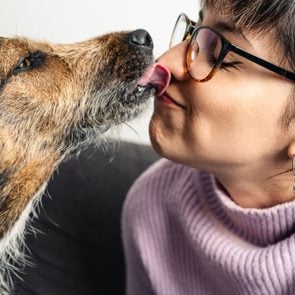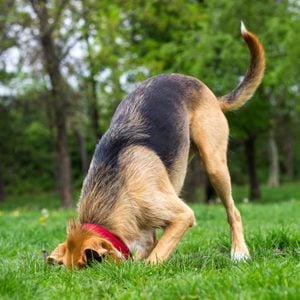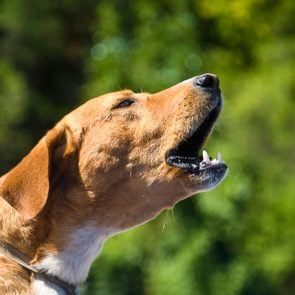What Your Dog’s Facial Expressions Really Mean
Updated: Apr. 26, 2024
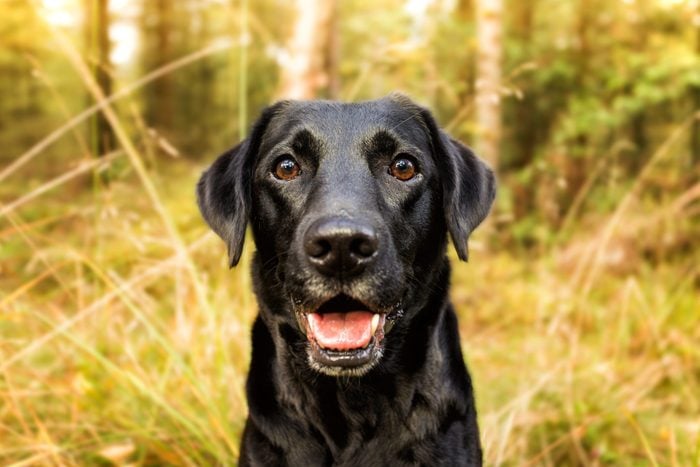
From squinting to staring to sticking out their tongues, dog facial expressions convey very strong messages. Here’s what your pup is trying to tell you.
Like most dog lovers, I’m a sucker for “puppy-dog eyes.” It’s probably my favorite of all the dog facial expressions. Whenever my Labrador retriever mix, Rio, wanted me to stop working and give him a treat or take him for a walk, he’d rest his chin on my knee and gaze into my eyes, raising his upper eyelids as if to say, “Please? Look how cute I am!”
I love looking at dogs’ faces not just because they’re cute but also to gain insights into what they’re feeling or needing. After my husband and I adopted Rio in 2010, I narrowed my focus as a journalist to pets and became passionate about learning as much as I could about dogs and sharing that knowledge with readers. And learning about dog facial expressions, in particular, helps us better understand dog behavior so we can keep our pups safe and happy and give them the best possible lives. Plus, it’s an important way to strengthen our bond with our dogs, according to animal behaviorist Nicholas Dodman, BVMS, co-founder of the Center for Canine Behavior Studies.
Just keep in mind that “full canine body-language literacy—understanding what a dog is signaling and how to interpret its mood—involves many signs,” Dr. Dodman says. “The mouth, ears and eyes all help you know what’s going on, but in many cases, the eyes have it.”
To help you decipher these canine clues, I spoke with Dr. Dodman and veterinarian Amy Pike, DVM, co-owner of the Animal Behavior Wellness Center in Virginia. Ahead, they’ll walk us through 15 common facial expressions dogs can make—and what they’re trying to tell us.
Get Reader’s Digest’s Read Up newsletter for more pets, cleaning, humor, travel, tech and fun facts all week long.
About the experts
|
Why do dogs make facial expressions?
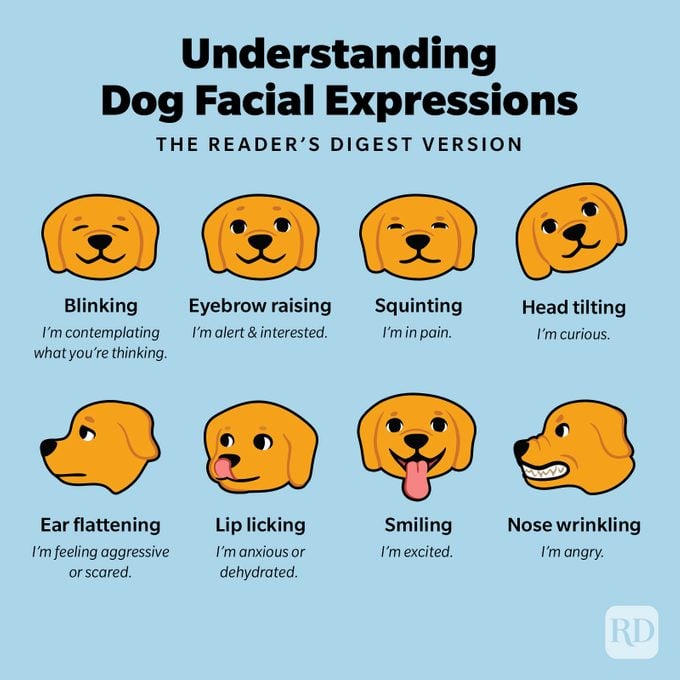
Dogs’ facial anatomy evolved over the past 33,000 years to help them communicate with other species—including, of course, humans. As they were domesticated, research shows, dogs began moving their eyebrows, ears, lips and mouths to convey positive and negative emotions like joy, fear, sadness, surprise, anger and pain.
It’s likely that humans selectively bred them for this ability. For instance, one study published in 2022 found that like humans, dogs have “fast-twitch” fibers in their face muscles that allow their mouths to pull back into a smile. (The percentage of fast-twitch fibers in samples of domestic dog breeds ranged from 66% to 95%, while gray wolves—dogs’ wild ancestors—averaged around 25%.) Another study, published in the Proceedings of the National Academy of Sciences, found that unlike wolves, dogs have muscles in their eyebrows that allow them to make those irresistible puppy-dog eyes.
In short, dog facial expressions are part of an entire dog language that also includes barking, tail-wagging and other body language. Being able to learn to read a dog’s face is one reason why the human-canine bond is so strong that we’ve dubbed them “man’s best friend.”
Why is it important to understand dog facial expressions?
People sometimes misread canine facial expressions, not only in relation to their own dogs but also dogs they meet in public. That can prevent us from knowing when they’re in pain or feeling fearful or anxious—and then lead to bites, according to Dr. Dodman.
But again, you should pay attention to more than just a dog’s expression. “Sometimes one sign stands out, but you [need to] take everything into consideration,” Dr. Dodman says. “I thought this statement from [a colleague] was useful: that if the dog is showing a ‘constellation of signs,’ always read the most threatening sign. You only need one negative sign to mean stand still, or even take a pace back, turn sideways or walk away.”
With that in mind, here’s what you need to know about a dog’s various facial expressions.
15 common dog facial expressions
1. Whale eye
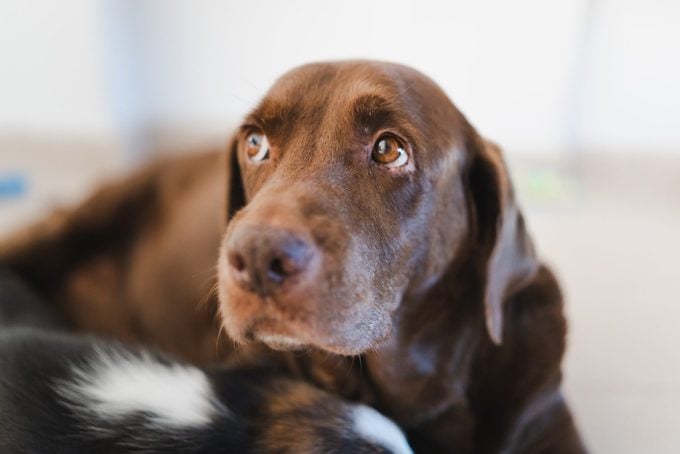
First-time owners might need help learning about dog facial expressions that signify fear, like whale eye, especially if they have children. A friend once showed me a video of their young son putting his face right next to a toy breed, some sort of Chihuahua mix, while talking loudly and roughly petting the dog. The screen filled with the dog’s eye widening so much, I could see the whites of his eyes, aka “whale eye.” A few seconds later, the dog bit the kid on the cheek—something that could have been prevented if the parents had noticed the dog’s whale eye and told the child to leave the pooch alone.
“Whale eye is a sign of fear, apprehension, worry—a sort of sideways look where you see the sclera, the whites of the eye,” Dr. Dodman says. “A lot of dogs show whale eye when they’re just plain scared.” A scared dog with whale eye might also have a tucked tail, ears back, a closed mouth and generally look like they’re making themselves smaller, he adds.
2. Staring
When a dog stares at you, it could mean one of two things. If it’s a soft gaze into your eyes, it could just be an expression of love. “When your dog looks at you with those soft, loving eyes and you look back, both of you release oxytocin, which is the hormone of love,” Dr. Dodman says.
In contrast, when a dog gives you a hard stare—direct eye contact focused right on you—the dog might be challenging you, and you should probably back off. “If you meet a strange dog on a walk and he stands there erect, tail up, stares right into your eyes, lowers his head a little bit, maybe even has his hackles up and ears pricked forward (if they’re applicable in that breed), that can be a sort of warning,” Dr. Dodman notes.
3. Avoiding eye contact
While a hard stare is very threatening in dog communication, dogs that look away are trying to avoid conflict, according to Dr. Pike. “If they are avoiding eye contact, they are trying to show the other person or dog that they do not mean any harm and may be trying to deflect tension,” she says.
Personally, I take notice of that when I’m petting a dog I’ve just met or even my own dogs. I’ll pet them for a moment and then pause to see if they look at me or look away. If the dog looks away, I realize they have had enough attention and are ready for some space. But if they look at me, I go back to petting them and whispering sweet nothings.
4. Lip licking
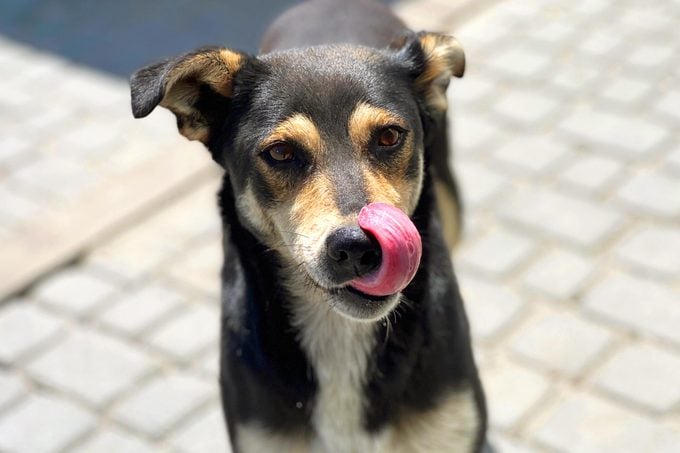
Just like when dogs lick their paws, it means something when they lick their lips. And if it’s not that they’re simply licking away food remnants (yum!), it’s generally a sign of stress. “Lip licking for stressful purposes will be faster, but the rest of the body language will also have to be taken into account,” Dr. Pike explains. For instance, closed eyes while licking can be another stress indicator, since they may be trying to avoid eye contact.
5. Raised lip
As with all dog facial expressions, it’s important to take a dog’s overall body language into consideration. “When they’re baring their incisor teeth—the front teeth—that’s aggressive,” Dr. Dodman says. “Clenching the mouth is not a sign of being relaxed.” In this situation, the dog might seem like they’re challenging you, with their body tense, their ears forward and possibly their weight on their front paws, leaning forward. They’ll generally seem “ready for action,” Dr. Dodman notes.
On the other hand, if the dog is raising its lips horizontally so they retract sideways, that is a sign of submission. “The vernacular is a ‘submissive smile,'” says Dr. Dodman. “So it depends on whether (the raised lip) is vertical or horizontal if it’s a submissive smile or a menacing gesture.”
6. Nose wrinkling
When a dog raises its lip vertically, you’ll probably notice nose wrinkling—another clue that a dog is reacting to you or your dog with aggression. “If somebody was to draw a cartoon picture of a dog who was being very aggressive, they would have it baring its teeth and its muzzle wrinkled,” Dr. Dodman says. When dogs contract their facial muscles to wrinkle their noses, their whiskers (or “vibrissae”) point forward, he adds.
Of course, nose wrinkling is harder to detect in brachycephalic breeds like bulldogs because of their “smooshed” faces.
7. Tongue out

Last year, my husband and I adopted a Yorkshire terrier mix whose tongue is a little too long for his mouth to fit comfortably. So Tux usually sticks out the tip of his tongue, an adorable trait called a “blep.” I’ve noticed that the more relaxed he is, the longer it gets. Sometimes when he’s sleeping, the tip of his tongue is longer than his nose! It’s ridiculously cute.
That said, complete and utter relaxation is not the only thing this type of tongue position can symbolize. It can also be a way to cool off by panting, or it can indicate stress, according to Dr. Pike. “When a dog is really relaxed and their mouth is open, their tongue will often ‘loll’ out the side of the mouth, but it is a really relaxed long tongue, even if they are panting,” she says. “But with a dog that is panting and stressed, the tongue will be forward in the mouth and often curled up tight, pointing toward its nose.”
8. Smiling
Your dog doesn’t need to be one of the most affectionate dog breeds to show you a “smiling” face. It just needs to be relaxed and happy. As noted above, a protruding dog tongue can be part of that smile. “The mouth tells you a lot,” says Dr. Dodman. “The happy mouth is not wide open, just hanging open loosely, relaxed, often with the tongue lolling out to the side. That would go with other happy things, like a soft eye and ears to the side or just flopping around. The whole dog looks relaxed.”
9. Squinting
In cases when a dog isn’t squinting simply because the sun is in its eyes, this facial expression is most often a sign of enjoyment and appreciation. For example, our miniature poodle, Peach, loved snuggling. She’d get so relaxed that she’d start to fall asleep but then open her eyes as if she didn’t want to miss anything. So she’d squint at us in what seemed like an adorable show of FOMO.
That said, squinting can also be caused by a medical problem like an ulcer or foreign body affecting a dog’s eyes, creating what’s called a “blepharospasm”—but usually this squinting is confined to one eye. (If you suspect a medical issue, contact your veterinarian.)
One way or another, a squinting dog is most likely not aggressive. “You wouldn’t see squinty eyes in a dog that was aggressive because their eyes would be wide—the lids would be retracted. That’s what gives you the impression and the reality of a hard stare,” Dr. Dodman says. “When you’re preparing for action, you don’t do it with your eyes half closed.”
10. Blinking
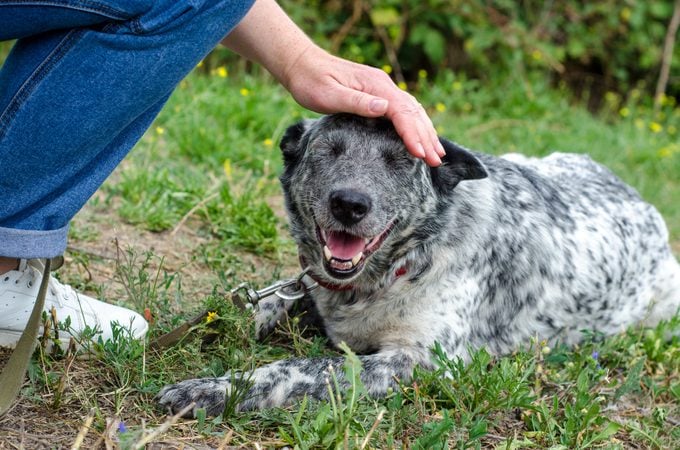
In tender moments, Rio would gaze at us, slowly blinking. Sometimes it was in a tent or in bed after a fun day of hiking, or after a party where guests had showered him with attention. “Blinky boy!” we’d declare, and usually give our loyal dog a treat for good measure.
But there’s a big difference between slow blinking and fast blinking. “Slow blinking likely means dogs are relaxed, content and comfortable,” Dr. Pike says. “But a dog will start to blink their eyes rapidly when they are stressed and uncomfortable.”
11. Yawning
I used to think a dog yawning was just a sign of an adorable sleepyhead. It’s true that like humans, dogs might yawn when they wake up. But like everything else regarding dog behavior, it depends on the context. “If the mouth goes wide open like a yawn, that’s a stress sign,” Dr. Dodman says. “You can imagine they might be stressed meeting a new person who’s getting a little bit forward. Then they might yawn, [which] indicates they’re under some kind of psychological pressure. This stress yawn is almost like an escape valve.”
12. Closed mouth
Sometimes I’ll be on a walk with Tux, and he’ll look at me near blooming flowers or a funny sign with the tip of his tongue sticking out. It seems like he’s smiling. But when I whip out my phone to take a photo, he abruptly closes his mouth and his tongue disappears, and it seems like he’s annoyed that I’m taking yet another picture of him. I’ve started saying, “Good photo!” afterward and offering him a treat to try to create positive associations with the camera. Sure enough, when dogs close their mouths, it can indicate that they’re uncomfortable.
“When dogs are uncomfortable, in addition to fighting or fleeing, they can fidget or freeze,” Dr. Pike says. “If a dog closes their mouth, they may be transitioning from panting and/or fidgeting to freezing. This can be very dangerous if the dog is transitioning to fighting because dogs will often do what we term a ‘micro freeze’ right before they attack, and closing their mouths is often part of that body language.”
13. Ears back
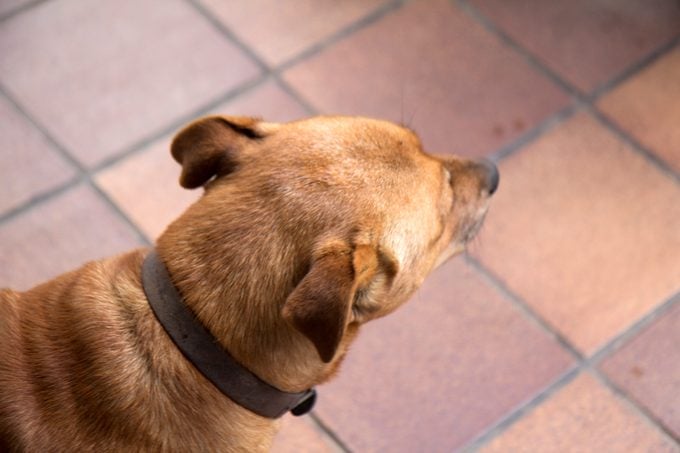
Similarly, a dog’s ears may ears pin back when it is feeling stressed or defensively aggressive as a result of fear, anxiety or stress. It can also happen when a dog is anticipating something like a change, according to Dr. Pike. This doesn’t just happen in dogs with pointy ears; you can notice this movement in dogs with floppy ears too.
When the ears aren’t totally flattened but sticking out to the side, there’s even more nuance. “‘Flying nun’ ears—pointed directly out to each side—are often a sign that the dog is attempting to be appeasing to another dog or a human,” Dr. Pike says. “For example, if a dog walks into a room and the other dog is guarding a bone, they will try to defuse tension and indicate that they mean the resource guarder ‘no harm’ by showing an appeasement behavior [like this].” This ear placement is also commonly seen in puppies, especially ones with pointy ears, around 4 to 6 months of age when they are teething; this has to do with a dog’s calcium needs, and their ears go back to the normal position for the breed afterward.
14. Dilated pupils
If an excited or frightened dog feels a rush of adrenaline, it’s remarkable: You can see it in their eyes. “If a dog is scared or basically releasing adrenaline—or epinephrine—for any reason, the pupils will dilate,” Dr. Dodman explains. “You see the pupils just large and black like a big black pool, because dogs can dilate their pupils very widely, so there’s almost no iris, almost no colors.”
One of Tux’s favorite activities is racing along our fence to bark at dogs passing by our home. His positive-reinforcement trainer told me he does this because of the adrenaline rush he gets and suggested curbing the behavior by training him to “come” when I see him running toward the fence—before he can start barking. He’s learning quickly, but sometimes I don’t notice in time. I’ll apologize to the neighbor and pick Tux up, then playfully say in a high-pitched voice, “Why did you do that?” When I look into his eyes after he’s been barking, he reminds me of The Muppets character Animal in a frenzy. His brown eyes are wide open and have seemingly turned completely black. He looks wild.
15. Head tilt
Of course, dog facial expressions can be enhanced when dogs tilt their heads to one side. My friend’s German shepherd, Fritz, would tilt his head so far to the side that it was almost perpendicular to his neck. It made us laugh every time. So why do dogs tilt their heads? One study published in Animal Cognition in 2021 found this head position is linked to intelligence—which tracks, since German shepherds are one of the smartest dog breeds.
“Some dogs will tilt their head when they are curious and also when they are ‘listening’ to a human talking to them,” Dr. Pike says. “Dogs that tilt their heads are often smarter than those who do not.”
Why trust us
At Reader’s Digest, we’re committed to producing high-quality content by writers with expertise and experience in their field in consultation with relevant, qualified experts. For this piece, Jen Reeder tapped her experience as a longtime pet journalist and former president of the Dog Writers Association of America, and then Wailani Sung, PhD, DVM, DACVB, a board-certified veterinary behaviorist who owns Bay Area Vet Behavior in San Francisco, gave it a rigorous review to ensure that all information is accurate and offers the best possible advice to readers. We also relied on reputable primary sources, including professional organizations and published research studies, as well as our writer’s personal experience. We verified all facts and data and backed them with credible sourcing, and we will revisit them over time to ensure they remain accurate and up to date. Read more about our team, our contributors and our editorial policies.
Sources:
- Nicholas Dodman, BVMS, DABVMS, DACVAA, professor emeritus at Tufts University, co-founder and CEO of the Center for Canine Behavior Studies and author of several books, including The Dog Who Loved Too Much and The Well-Adjusted Dog; phone interview, March 20, 2024
- Amy L. Pike, DVM, DACVB, IAABC-CDBC, Fear Free certified professional, former Captain in the U.S. Army Veterinary Corps and co-owner of Animal Behavior Wellness Center; email interview, March 25, 2024
- PNAS: “Evolution of facial muscle anatomy in dogs”
- Animal Sentience: “Animal sentience: history, science, and politics”
- Animals: “Current Advances in Assessment of Dog’s Emotions, Facial Expressions, and Their Use for Clinical Recognition of Pain”
- The FACEB Journal: “Dog Faces Are Faster than Wolf Faces”
- Animal Cognition: “An exploratory analysis of head-tilting in dogs”


